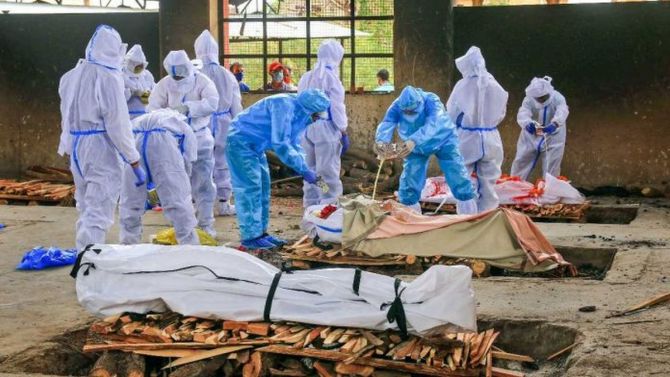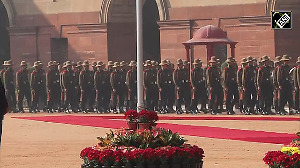Experts believe that under-reporting is likely to cause an underestimation of the spread of the disease.
Rashme Sehgal reports.
Caution: Graphic content. Viewer discretion is advised.

Was the undercounting of COVID-19 deaths during the Second Wave part of a deliberate cover up by state governments not wanting to reveal the massive increase in fatalities?
There has been a huge mismatch between official data and the numbers thrown up by checking death statistics in the offices of the Civil Registration System and those gathered from crematoriums and burial grounds show a huge variation.
So much so, that several states are now involved in the task of revising their COVID-19 death estimates.
Bihar is one such state whose health department claimed 2663 COVID-19 deaths had occurred between a period of April 1 to May 20.
But during this same period, five crematoriums in Patna and one each in Bhagalpur and Muzzafarpur recorded 3,940 deaths which makes it 1,277 deaths more than the official figure.
In its revised estimate, the Bihar health department added 3,,951 deaths but even this is a gross underestimate because it does not include deaths that occurred in villages and the rural hinterland.
Maharashtra as accounted for a quarter of India's more than 15 million cases.
The death rate in Maharashtra was calculated at 106,367 since the outbreak of the pandemic.
Despite having better testing facilities than those available in the cow belt, the Maharashtra health department was forced to revise its official figure by adding more than 10,693 deaths.
Similarly, in the national capital Delhi, over 4,500 people slipped through the cracks of the Delhi government state records between April 18 and May 11.
The Delhi government, following sharp criticism, has revised its figures upwards of 1,500 deaths.
Given the magnitude of the wave and the speed with which it spread across the country, some under reporting was to be expected.
Both WHO and the Indian Council for Medical Research encouraged nations to adopt a liberal definition of a Covid death, but state after state in India has insisted that only those individuals who tested Covid positive and died in hospitals would be counted as Covid dead.
Andhra Pradesh, for example, saw 130,000 'excess deaths' over and above their earlier average for 2019-2020 increasing the death toll by 34 times the official Covid death toll for the same period according to official statistics.
Reports point out that Andhra Pradesh reported over 130,000 deaths in May this year which was five times the number of deaths reported during this month. The state saw 27,100 deaths on average in May 2018 and 2019.
Madhya Pradesh reported just 4,461 Covid deaths between January 1 and May 31, 2021. It has been calculated on the data accessed by CRS and crematoria showed that excess deaths in this same period were 42 times more than what the MP government has reported.
Though, of course, not all these deaths can be attributed to COVID-19.

The Gujarat government's official Covid death toll for March 1-May 10 was 4,218.
It was left to the media in both states to accuse the state government of hiding the actual numbers.
In Madhya Pradesh, the Hindi newspaper Dainik Bhaskar whighlighted that the actual number of deaths was three times higher than what had been reported by the state.
Similarly in Gujarat, the Gujarati daily newspaper, Divya Bhaskar did a detailed investigation based on the obituary notices in local newspapers which showed the death toll in their state was much higher than the figures being trotted out by the state government.
A team of journalists from Divya Bhaskar began to look at the number of official death certificates issued by the government between March and May 2021.
They found that the Gujarat government had issued 123,871 death certificates in 71 days between March 1 and May 10, 2021.
This was more than double the number issued for the corresponding period in 2020 going on to conclude that these 65,781 excess deaths were caused by Covid deaths.
Gujarat Chief Minister Vijay Rupani justified the under reporting of deaths stating that his government was only following ICMR guidelines which lays down that death of patients with co-morbidities cannot be regarded as Covid deaths.
These state governments have stonewalled queries relating to death data with MP CM Shivraj Singh Chauhan filing an FIR against state Opposition leader and former CM Kamal Nath for 'misleading' the public when the latter released data gathered from crematoriums and cemeteries showing the death rate to be much higher.
The number of 'excess deaths' registered by the CRS in Karnataka between April 2020 to May 2020 was 167,788 which is nearly six times higher than the official reported figures of 29,000 deaths for the same period.
Tamil Nadu registered nearly 400,000 deaths between January 1 2020 and January 13 this year while the average deaths registered annually in 2018-2019 were 593,000.
Assuming deaths are spread out evenly throughout the year, the state registered an estimated 129,000 deaths in the first six months of this year making it 7.5 times higher than the official Covid death poll for this period.
India's most populous state, UP, saw a total of 851,620 infections and 9,830 deaths since the pandemic began last year.
It did not fare too badly during the first wave, but the situation deteriorated sharply during the second wave where inadequate testing especially in its rural hinterland has ensured that proper stats are not available.
The sight of corpses being thrown into the Ganga as also being buried along its banks brought home this grim reality as did disturbing images of overcrowded testing centres, hospitals turning away patients and funeral pyres burning round the clock.
Why are the state governments not forthcoming with correct data given that a country like the United Kingdom has made it a rule that every single death gets registered and death statistics be released on a daily basis?
Dr Sunil Kumar, secretary of the Indian Medical Association's Bihar chapter, cites the example of his state government announcing a payment of Rs 400,000 to the family of every person who died of COVID-19.
Unable to pay so much compensation it wants to trim down these figures, Dr Kumar claims.
But this issue is contentious as the central government informed the Supreme Court that neither it nor the state governments had the requisite funds to pay Rs 400,000 to families of each COVID-19 victim.
How this situation will unfold amongst different states has to be seen given as the case is presently being argued out in court.
Then health minister Harsh Vardhan's claim on April 29 that India had one of the lowest COVID-19 death rates flies in the face of evidence collected by journalists, from CRS records and activists who have shown quite the contrary.
The other anomaly in this under reporting saga is that while the Modi government has not hesitated to chastise the West Bengal government for showing a discrepancy in COVID-19 death numbers, no such public chastisement has been forthcoming for the Bharatiya Janata Party ruled states of Karnataka, Haryana, Gujarat, Madhya Pradesh and UP, all of whom have desisted from making any upward revision of their death data.
What does the medical community make out of this gross under reporting? Senior epidemiologist Dr Jayaprakash Muliyil believes that the majority of Indian hospitals have a problem with medical reporting of deaths.
"Traditionally government hospitals have a column titled 'Discharged Against Medical Advice' which is used to discharge patients even after their death," says Dr Muliyil. "When you have a death (inside the hospital) you have to do a lot of paper work which they want to avoid. This is the done thing. I saw it even as a medical student. Our hospitals do not specialise in the disposal of dead bodies."
"A large percentage of deaths taking place at home are not being reported. Some of this under reporting is deliberate," adds Dr Muliyil, insisting that "sero surveys at the grassroot level are the most effective way to provide information about the prevalence of the disease, a first step to being able to control it."

Virologist Dr Shahid Jameel, director of the Trivedi School of Biosciences at Ashoka University, believes that "Even at the best of times hospitals do not record death records well", but during the present pandemic, there seems to be "a wilful neglect on the part of state governments."
"If deaths had been properly reported, it would have helped contain the pandemic. If there was plenty of oxygen in one place, it could have been transferred to another area facing a shortage. The entire allocation could have been dynamically handled. Instead, there was an active suppression of information. Those doctors which went public to state they did not have enough oxygen were slapped with FIRs," points out Dr Jameel.
Experts believe that under-reporting is likely to cause an underestimation of the spread of the disease.
This creates a data vacuum which will hamper the ability of India's already overwhelmed healthcare system to respond to a possible third wave of infection.
Feature Presentation: Aslam Hunani/Rediff.com










